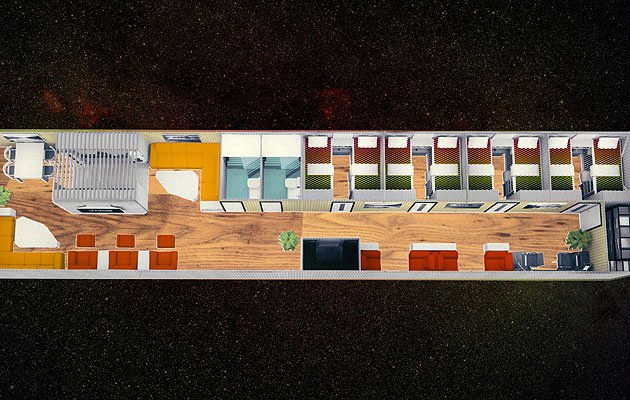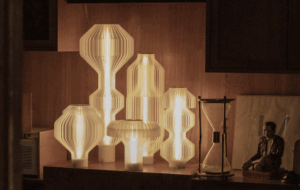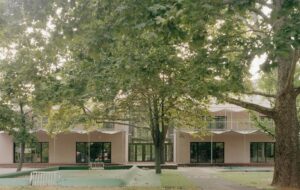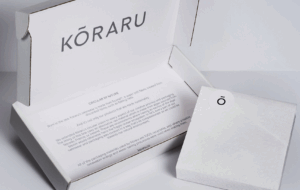|
|
||
|
There is nothing fearsome in the word ‘shelter’, ” announced the text for a rather curious exhibition, held in Chicago in 1960, that commingled the work of the American Institute of Decorators and the National Office of Civil and Defense Mobilization. “It is a pleasant-sounding word. Men seek shelter from any excessive condition – shelter from the storm, the heat, the cold, the noisome pestilence.” But they had in mind an entirely new condition: the blast wave of an atomic device, and the subsequent irradiation of the landscape. “Atomic radiation is a new building design element to be taken into account,” noted Architectural Forum, “with wind, weather, and sanitation.” As Cold War tensions escalated in the US, architects were enlisted in an energetic programme to essentially normalise the idea of atomic-resistant living. “Building against the atom,” as it was called, was posited as a rational science. The “new buildings for the perilous atomic age”, tested at the atomic proving grounds in the Nevada desert, were built with the curious dynamics of nuclear attack – perverse forces like “reflected overpressure” – in mind. Many prototypes were built. Texas builder Jay Swayze marketed an underground house in a popular exhibit at the 1964 World’s Fair: “The clamour of traffic, jets, noisy neighbours – all are gone with a turn of the switch.” A few years ago, I visited the only surviving Swayze project, an otherwise suburban-style underground house, a few blocks off the strip, complete with artificial lawn, a Jenn-Air grill, and dreamlike “views” – actually stylised representations of the owner’s favourite landscapes, painted on the circular subterranean walls (thanks to fluorescent paints, the lights of Los Angeles glitter on one wall at night). And it wasn’t just rich eccentrics. In 1962, America’s first all-underground school was built, in Abo, New Mexico. The lead behind that project, a Roswell architect named Frank Stanhardt, actually envisaged something more grandiose: the “Del Norte Sheltered Shopping Center”, a 10-acre facility, to be located near Roswell, that would combine consumption with survival (not to mention echoes of Dawn of the Dead). For $250 down, investors were assured a variety of benefits in “near normal conditions”. Although local banks promised financing, the project fell apart owing to civic objections over the project’s members-only policy.
This speaks to one of the many contradictions that eventually undid the idea of nuclear civil defence in the US. As much as fallout shelters seemed to be in the zeitgeist – who was to say their neighbour wasn’t building one? – very few were ever actually built. Apart from the cost, and the confusion over whether they would actually be effective, there was, as historian Kenneth Rose argues in One Nation Underground, a broad cultural current against going underground, “a conscious decision based on the social, moral, and economic implications of building those shelters”. The idea of societal triage was too much for many to bear. Rose writes: “Even Dwight D Eisenhower proclaimed … that if he found himself in a shelter without his family, he ‘would just walk out. I would not want to face that kind of a world and the loss of my family’.” But just as the nuclear threat did not vanish – and indeed, was joined in the collective consciousness by any number of threats biological, chemical and otherwise – the idea of post-apocalyptic living never went away; instead, like the military’s defence structures themselves, it lay dormant and out of sight, only to rise again in the public mind during moments of geopolitical strife. In the early 1970s, the oil crisis, along with Malthusian worries of overpopulation and resource depletion, sparked another boom – this time in “earth-sheltered” housing or the capsule-style living schemes envisioned by defence contractor Grumman. And in the 1980s, in the wake of Chernobyl and the re-emergence of Cold War tensions under Reagan – the famous “doomsday clock” of the Bulletin of the Atomic Scientists stood at three minutes to midnight – a Utah developer named Lane Blackmore announced a proposed $10 million, 240-unit subterranean condominium unit named Terrene Ark I. Interest was high, franchising discussed. “I’m getting doctors and lawyers in here, not kooks,” he said. “These are really quite prudent people who know how to live in the nuclear age.” (Indeed, one of the first condominium-style shelters was built by a group of nuclear scientists at Lawrence Livermore Laboratory in 1961, under a group called Survival Associates, Inc). Alas, while Blackmore collected a number of deposits, the project never got off the ground – or rather, underground. The doomsday clock may currently stand at seven minutes to midnight, but the 21st century has ushered in a new world of shelter. Any number of underground defence facilities, for example, have been converted into “data bunkers,” holding servers and storage. One facility, near Houston, was originally built by a nuclear-war-fearing nephew of former Chinese Nationalist leader Chiang Kai-shek; another, the Info Bunker, occupies a 65,000sq ft former air force bunker, built five storeys deep, in Iowa. The German company ABC Guard builds NBC-resistant (nuclear, biological, chemical) “protection shelters” (certified by the Germany’s Federal Office of Civil Protection and Disaster Assistance), while Hardened Structures offers “military grade” shelters designed to “mitigate all 2012 scenarios” (this is the year, as we have been told by everyone from reputable anthropologists to “past lives regression therapists”, that a “world age cycle”, as projected by the Mayan calendar, will end). For $50,000 ($25,000 for children), California-based company Vivos (“The Next Genesis”) will also offer a safe haven from a range of future catastrophes, billing itself as “The Underground Network for Long-Term Survival of Future Catastrophes”. The brainchild of Robert Vicino, a real estate developer (who first found fortune by inventing the market for giant inflatables – think King Kong straddling the Empire State Building for the 50th anniversary of the film in 1983), Vivos has been buying a number of disused Cold War-era facilities in the US and Europe. One, near Barstow, California, in the Mojave desert, was a repeater station built by telecoms company AT&T and the Department of Defense as part of a once top-secret system meant to keep the nation’s communications channels open in the event of catastrophic nuclear war. It is also planning a massive underground shelter complex, to be located in central Europe, that will accommodate 2,000 people for up to one year after a catastrophe. The first Vivos facilities are set to be ready for use in early 2011, according to its website. “These facilities will vary in their intensity and capacity,” says Vicino. “The ones we’re doing are able to withstand 50 megatonnes within 10 miles, which is huge. Some of these shelters are so strong they can be shoved sideways through the earth 30ft without damaging the structure.” Baffles provide an architectural defence to the awesome power of nuclear blast waves. As part of its retrofit of facilities, Vicino says Vivos installs the latest in NBC-resistant measures, as well as making aesthetic upgrades. “We completely refinish the interiors, turning them into four-star hotel quality, but not over the top,” he says. “Because you’re going to be down there for a while, we want to make it comfortable.” There will also be a jail, but Vicino says he does not anticipate much trouble. “You’re going to have a lot of people with security skills that will have very little to do with their time – I think we’ll be able to control people.” Vivos also hopes to avoid trouble with a screening process. “We’re not looking for ‘designer people’,” insists Vicino. “We’re looking for diversification. Once we have members screened from a ready and able standpoint, we then look at what their expertise is; you might have a doctor who’s also a farmer and a pilot and who knows how to use a gun.” The Vivos shelters will be fitted out with enough freeze-dried food for a year’s residency. “We think it’s long enough to survive 99 percent of the scenarios,” says Vicino. “Beyond that, what’s enough? Pick a number. Five years? 50 years?” The more time, he says, the more storage and the more square feet required — and the higher the cost. “We try to make it as comfortable as possible for as long as possible and as affordable as possible.” For those who cannot afford the price tag, Vicino tells me he is working on a reality show, “probably coming next spring”, in which families will compete for a spot in Vivos (it’s not yet clear whether this competition would take place in the bunker itself). And for those whose budget doesn’t quite stretch to four-star post-apocalyptic living, there is another path to survival. “We’re creating a doomsday cryovault, to preserve the seeds of humanity,” says Vicino. It works like this: clients will be sent a package. After depositing a specimen, the package will be delivered to Vivos, where it will be tested for “fecundity and fertility”. That specimen, says Vicino, “will be preserved in the cryovault within the facility forever. The thought is: if you can’t survive, maybe your genes can”. The primary difference between the new-look shelter market, as represented by Vivos, and the atomic-resistant architecture of mid-century America (and beyond), is that there is no longer just one source of threat, actual or imagined. In addition to the ongoing programmes of targeted nuclear missiles, there is a panoply of hazards: from individuals toting “dirty bombs” to rogue viruses like Stuxnet that could cripple entire infrastructure grids, from globalised viruses to global warming. 2012, that date handily provided by the Mayans, looms as a collective catch-basin on incipient fear. “Many believe that 2012 is going to be a critical date,” says Vicino. “NASA says we’re going to have a solar extreme in June of 2012, with coronal mass ejections [huge bursts of solar wind]. The question is whether one is going to hit the Earth. If it does, it takes out our electrical grid – these are severe jolts of electromagnetic energy.” Vicino recalls the 1857 Carrington Event, a solar flare that took out the internet of its time: the telegraph office. “If it happens again,” he says, “you’re not going to have Twitter, and you may not have the twit that lives next door either.” |
Image Claire Scully
Words Tom Vanderbilt |
|
|
||
|
|
||



















